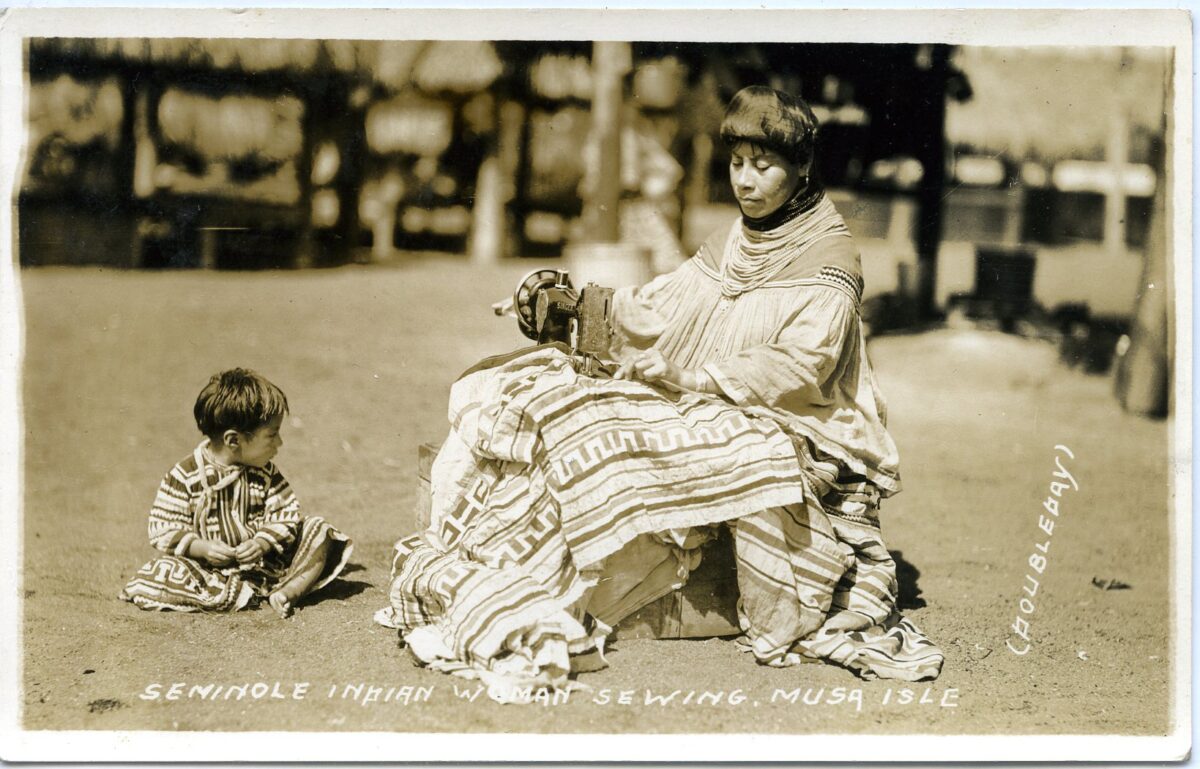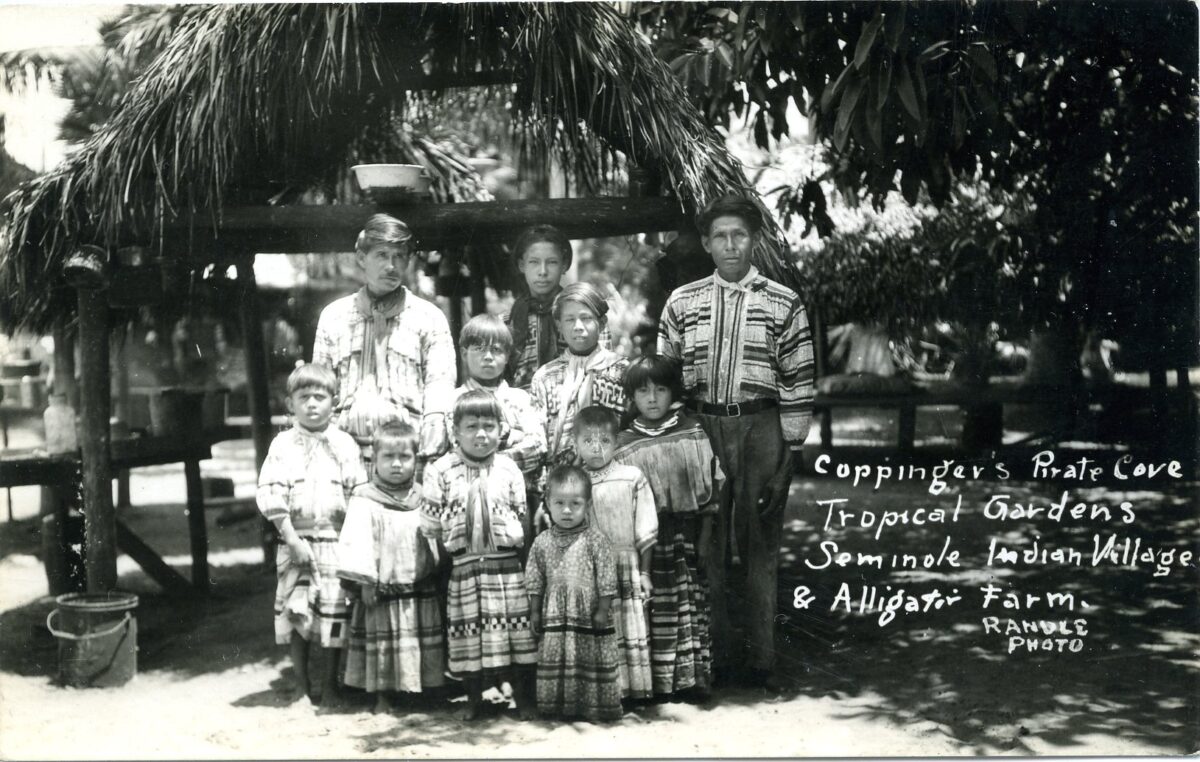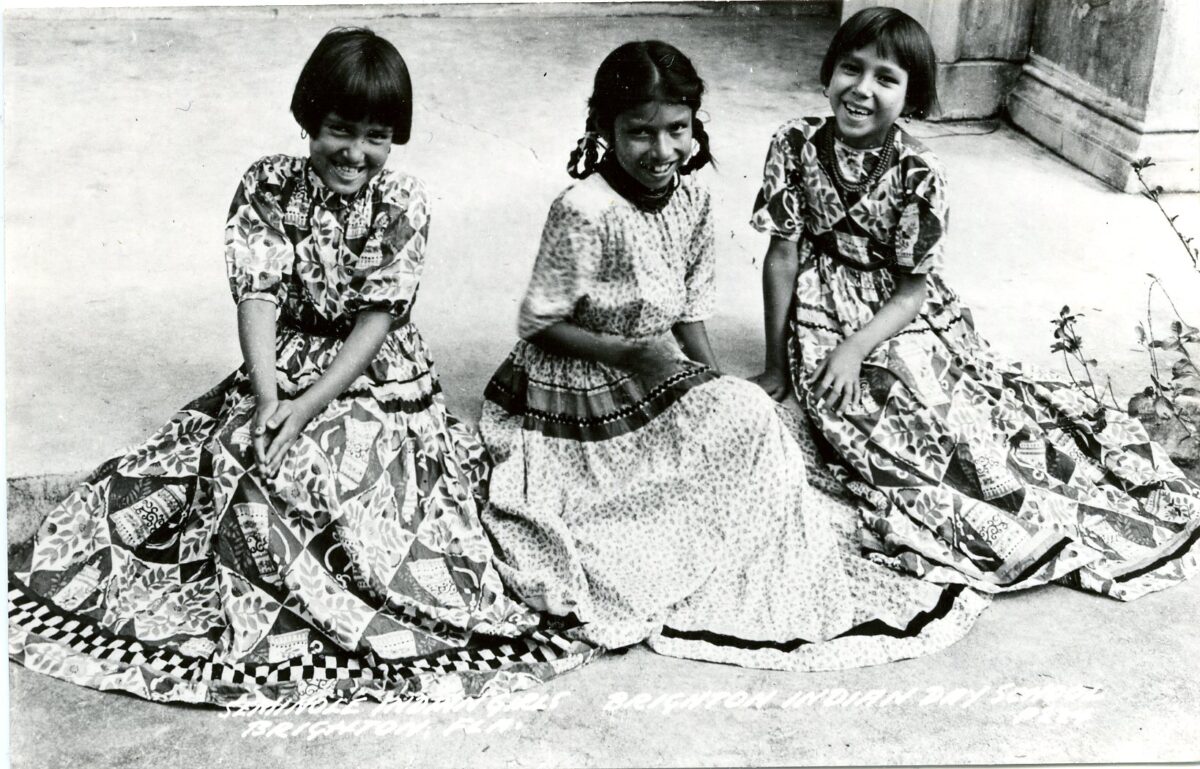
Exploring the Ah-Tah-Thi-Ki Museum’s Online Collections
Do you want to learn more about the Seminole Tribe of Florida, but aren’t sure where to start? While visiting the Ah-Tah-Thi-Ki Museum in person is the best option, there’s another great first step right at your fingertips! Why don’t you explore the Ah-Tah-Thi-Ki Museum’s Online Collections? The Ah-Tah-Thi-Ki Museum cares for and manages almost 200,000 unique artifacts and archival items. Many of these are available for you to digitally view through the Museum Online Collections. Art, dolls, patchwork, baskets, photographs, and more are all available to view online at your leisure. This week, we will peek at these Online Collections, what they contain, and how the Museum manages and grows them. So, take a tour with us and get exploring!
About the Collections
The Ah-Tah-Thi-Ki Museum on the Big Cypress Seminole Indian Reservation is home to almost 200,000 unique artifacts and archival items. The Collections contain items relating to the Seminole Tribe of Florida. Additionally, they contain items relating to the Native American tribes of the Southeastern United States. Each item is important to the Seminole story, and helps fulfill the goal of sharing and maintaining Seminole history and culture. This includes historical newspapers, manuscripts, patchwork, baskets, dolls, military items, and more. The Online Collections are a robust picture the Museum’s diverse collections. While not every item is available online, many can be accessed. High quality pictures and scans are available for you to peruse. Each catalog entry also contains relevant background information, detailed identification, and provenance of the items.
The Museum adds to the Collections through private donations and a rigorous acquisitions program. But, the Museum works hard to not take in more objects than they can appropriately care for. Occasionally, the Museum repatriates items to other tribes and entities. A recent Seminole Tribune article covered one such instance. In late 2021, the Museum received a donation of almost 100 books relating to the culture and traditions of a number of Native American tribes throughout the United States. Many were rare and historically significant. The Ah-Tah-Thi-Ki Museum added twenty-seven books to their library collections. However, the Museum staff worked diligently to repatriate the other books to their rightful homes. In the last year, thirty-two books have been returned to several tribal museums, cultural centers, and schools. An additional thirty volumes and annual reports were sent to the University of Florida in Gainesville, FL.
What else does the Museum do?
In addition to the exhibits, outreach, events, and educational materials, the Museum does a lot of work behind the scenes. The Museum cares for a robust research library on site, which consists of books, journals, and research materials. These materials relate to Seminole history and Native American history in the Southeastern United States. The library is closed to the public. But, some items are available for scholars and researchers, when appropriate. Seminole community members are always welcome to view the Collections, or conduct research within the library space.
Oral histories are a vital and precious component of the Museum’s Collections. They archive oral interviews of Tribal members and members of the public, to preserve Seminole history, memory, and culture through recordings. The Oral History Collection and Language resources are available only to Seminole Tribal Members. But, the public can access a selection of non-tribal interviews and podcasts.
Behind the scenes, a fully functioning Conservation program works to care for every single object within the Museum Collections. The Museum’s on staff conservator takes an active role in preserving these objects related to Seminole history and culture. Like a doctor, this is accomplished by examining, diagnosing problems, performing regular check-ups, and creating action plans for problems. They regularly assess each object for deterioration, damage, and other issues. The conservator then designs comprehensive treatment plans after careful consideration about what is best for the object, and its importance. Unfortunately, preservation is a losing battle.
Most of these objects will eventually turn to dust. The treatment plans are designed to slow this destruction, and keep the objects as safe as possible for future generations. The Museum integrates these goals of conservation into all aspects of management. Temperature and humidity control, light management, and pest control practices are standard throughout the Museum spaces.
Exploring the Online Collections
But, how do you explore the Collections? Below, we have compiled a few examples of how to navigate this online treasure trove. It may seem daunting, but don’t worry! Before you know it, you’ll be getting lost in all the Online Collections have to offer.
Random Images
This is a favorite way to explore the online offerings. Random images from anywhere in the Online Collections are available at the roll of a dice. It is a great way to browse the Collections without a clear purpose. When you click Random Images – that is exactly what you will get. You will see twenty-eight unconnected images from within the Online Collections, each which can be selected for more information. We accessed the image below randomly within the Museum Collections. The picture is part of the Boehmer Collection, photographs taken by William D. Boehmer. It is a black and white photographic print of Henry Osceola, Jake Morgan, Wilson Cypress, John Josh, Josie Jumper, John Henry Gopher, and Cuffney Tiger cooking barbecue in 1938. They gathered for the 1938 Field Day dedication of a new school building.
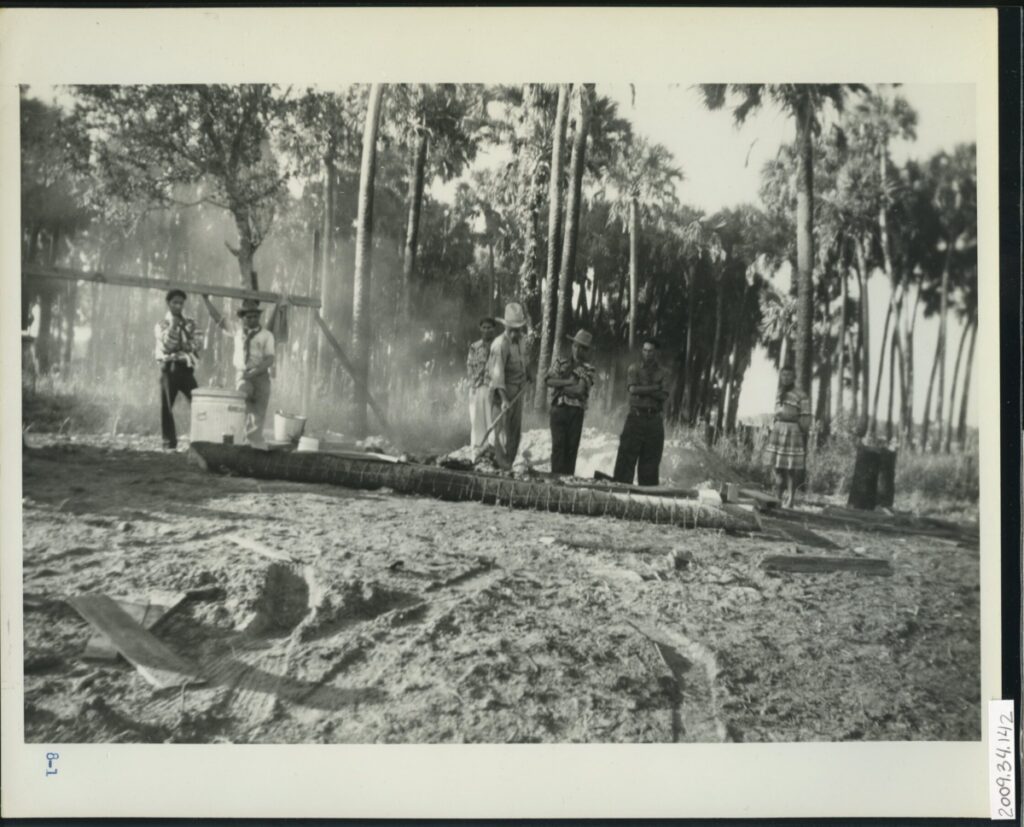
2009.34.142, ATTK Museum
Keyword Search
The Keyword Search lets you search generally across multiple fields, and across all catalog records. If you are using the keyword search, there are a few rules to be aware of. If there are two words within your search, they will be connected automatically with OR. So, if you are searching Field Day, the search will return items that either contain Field OR Day. If you would like those two words connected, you would use the connector AND (ex. Field AND Day.) Additionally, you can put longer phrases in quotes to return items relating to that exact phrase. Wildcard searches use an asterisk (*) to return different possibilities that start with the same root. For example, a search “hist*” would return records that contained history, historical, histories, etc. You can also select for the search to only return images.
Below, we found this image using a phrase. Through the keyword search, we searched “1938 Field Day” and selected only images. This image is a black and white photographic print from the same 1938 Field Day as the above image. But, it depicts the pie eating contest. Richard Osceola is identified in the black hat.
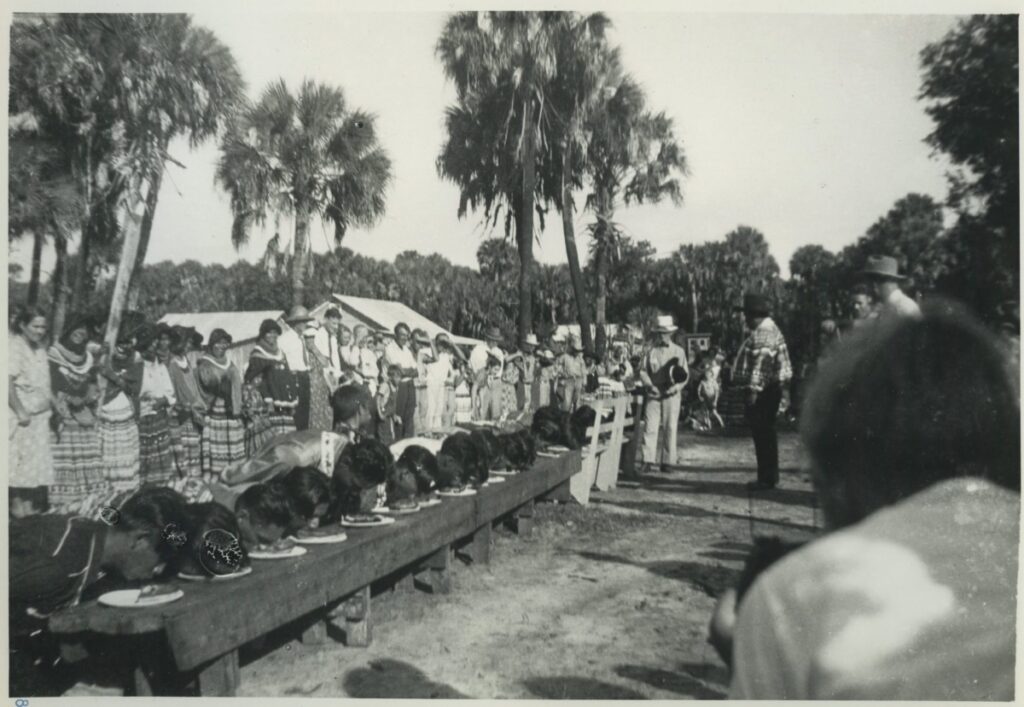
2009.34.145, ATTK Museum
Advanced Search
The Advanced Search allows you to be much more specific about what you are looking for. Not only can you search for a specific word or phrase, but it also allows for searches across multiple fields. This way, you can narrow the search down to a very specific set of conditions, and leave out unnecessary items. There are a lot of fields, so don’t get caught up in how many options there are!
For the below picture, we searched by Collection. Like the above photos, we chose to look for items within the Boehmer Collection, photographs taken by William D. Boehmer. In this photo, Nancy Shore, Lottie Shore, Mary Jane Shore, and Mollie Shore pose in front of the Stephen Foster Memorial Building during the 1958 Florida Folk Festival. To learn more about the Florida Folk Festival, visit a previous blog post here! The Frank Shore family of the Brighton Reservation were guests at the Florida Folk Festival of White Springs, FL for many years.
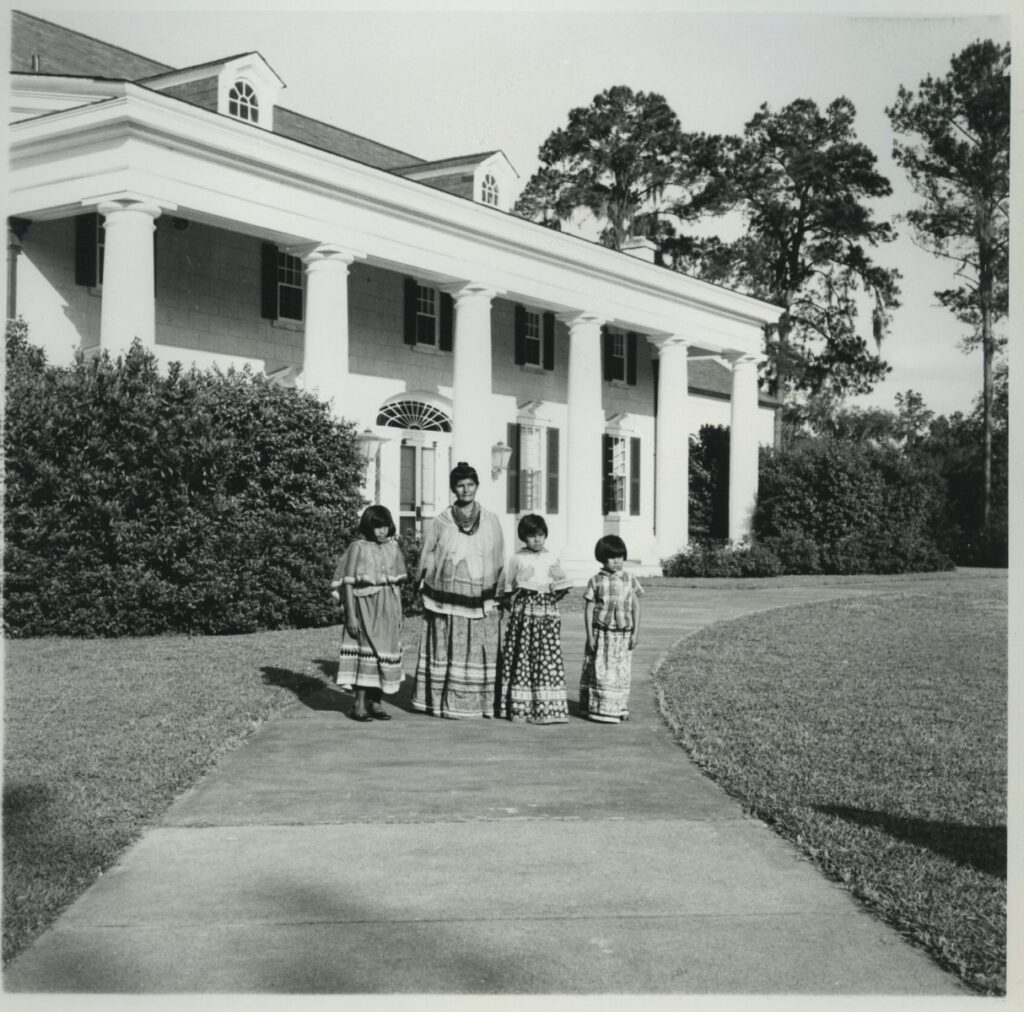
2009.34.1015, ATTK Museum
Catalog Searches
The final option for searching through the Collections is by Catalog Search. There are four main catalogs; Archives, Photos, Libraries, and Objects. These catalogs narrow down your search before you even enter in a keyword. To use this option, simply click on the tab for the catalog you desire, then enter in your keyword. Much like a general keyword search, you can use AND/ OR statements, as well as phrase and wildcard searches. You can also browse the catalog without searching further.
This week, we selected our featured photo using this search option. Under the Archives catalog, we searched the keyword Postcard. The image is a black and white Real Photo postcard. It shows three smiling girls dressed in traditional clothing. It is a photo from the Brighton Indian Day School in Brighton, FL. From left to right are Leah Johns, Tina Gopher, and Edna McDuffie.
The Seminole Tribe of Florida places priority on maintaining, preserving, and cherishing their culture and history for generations to come. We encourage you to explore and enjoy the Ah-Tah-Thi-Ki Museum Online Collections! There is a wealth of information at your fingertips.


